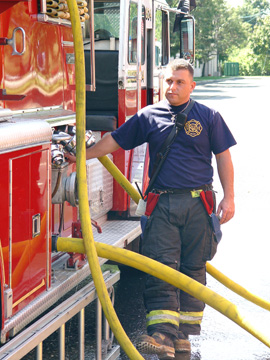Posted
August 28, 2004 · Photos by Fritz Rethage
· [HHFD Index]
Mass Decontamination
[Group
2 photos][Group 3 photos]
The
radio crackles: "There has been a contamination of unknown substance
at ...." Office building, factory or stadium -- regional
first responders are trained to handle the decontamination of large
numbers of people.
Carlstadt, Hasbrouck Heights, Little Ferry, Moonachie, Wallington
and Wood-Ridge Fire Departments* participated in this hands-on
mass decontamination exercise. The training was held on August
22, 2004 at a Route 46 office complex parking lot in Hasbrouck
Heights, NJ. Classroom instruction preceded this drill.
This course is given to every fire department in Northern New Jersey
and with this common training -- all departments can mobilize in highly-coordinated,
scalable efforts.
Mass decontamination removes lethal contaminates from a large number
of victims to increase their survivability and to reduce the threat
of secondary contamination. By comparison, a technical
decontamination is the regimented method used by hazardous materials
teams and may employ the use of solutions to clean or neutralize a
chemical product.
With first responders handling mass decontamination, it frees up hazardous
material technicians to take more specific action. A mass decontamination
can be run without definitive agent identification.
Upon arrival at the scene, first responders first assess the situation
and set up accordingly. It is crucial to communicate with the victims
by providing reassurance and describing the decontamination procedures.
The operation is positioned upwind, uphill and upstream of the event.
The basic technique is to set two engine companies parallel about
12 to 20 feet apart with pump panels facing outward. Apparatus should
not be running (to avoid carbon monoxide buildup) and utilize hydrant
pressure or have pressure supplied by another engine away from the
decontamination area (see photos below). Ladder companies can
also be utilized either with the pumpers or as a stand alone unit
(see group 3 photos).
Nothing can be done about the runoff created by mass decontamination
procedure. The EPA stipulates that priority should be placed on saving
lives. If possible, operations should be positioned uphill so
that the contaminates run back into the affected area.
A mass decontamination corridor is formed by placing ladders between
apparatus and covers attached to provide privacy. Hoses are
set up with "wide angle fog spray" at 60 gpm -- similar
to a strong shower (see group 2 photos).
Additional units can be set-up for larger numbers of victims and units
can be created for male, female and family. Up to 400 people per hour
can be decontaminated with this configuration.
Removal of clothing is the essential first step. Once the clothing
has been removed, the victim will remove over 80% of the contaminate
after a liquid contamination, and nearly 100% after a vapor contamination.
Victims disrobe down to their undergarments. The clothing is
then bagged. Victims enter the corridor and slowly pass through
the "shower" for maximum flushing with water .
Victims are directed to scrub themselves from one to three minutes
using laundry detergent or household bleach. After exiting the
corridor, victims can wear inverted trash bags with holes made for
head and arms for modesty purposes.
Decontamination during colder temperature require special consideration
to avoid hypothermia.
Injured need decontamination prior to being treated and transported
to a medical facility. Hospitals will close if patients contaminate
their emergency rooms thus negating the benefits of hospital access.
As much clothing as possible is removed from the patient. Victims
may require decontamination while they are on stretchers.
Once decontaminated, ambulatory victims are to be moved to a
safe refuge upwind and with access to the operation. This removes
them from contaminates, allows for better communication and observation.
EMS personnel at the scene treat patients according to symptoms.
Triage will sort priority transportation. Those not injured
or symptomatic are moved to shelter for further evaluation.
It is expected at least a 5:1 ratio of unaffected to affected causalities.
Not all exposed will be contaminated. The number of people exposed
is directly affected by the type of release, confinement of release
(inside or outside) proximity of people to release, duration of release,
amount, concentration and purity of product and release mechanism.
This drill was limited to chemical and biological agents and did not
address other potential WMD such as explosives, incendiary devices
or nuclear weapons.
The entire incident is a crime scene requiring that the proper evidence
collection and chain of custody be maintained. Patients could
be suspects and their belongings may be evidence. Removal of
clothing in the decon procedure has the additional advantage of detecting
weapons or a secondary device.
[Photos of Hasbrouck Heights
Police Department during hazardous first response training.]
The trainer was Larry Rauch, Coordinator of Safety Programs at Bergen
County Law & Public Safety Institute in Mahwah, NJ.
* South Bergen Mutual Aid Association Zone Two
#####
Sources include:
· FireEngineering.com -- Mass Decontamination: Dispelling the
Mystery by Mark Edie and Steve Wood
· Firehouse.com & mfri.org (Maryland Fire and Rescue Institute)
-- Mass decontamination for First Responders: Drill of the month for
March 2003 by Clarence "Smiley" White
#####
[Group
2 photos][Group 3 photos]

Training orientation

Setting up hoses




Adjusting the water pressure





Trainer Larry Rauch provided a review
of set up
[Group
2 photos][Group 3 photos]
######










